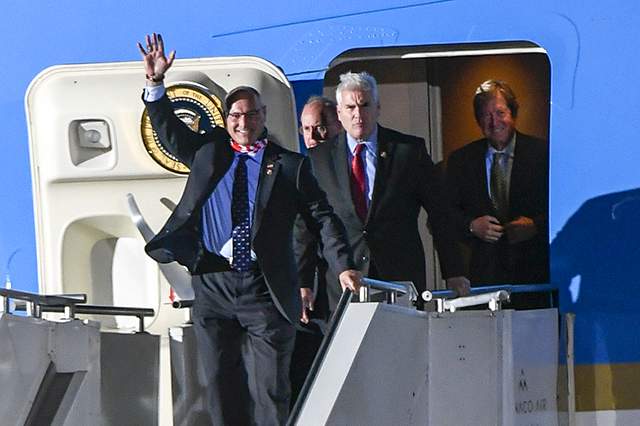When Eighth District Rep. Pete Stauber talks about bipartisanship, he likes to say Congress should be more like the 1980 U.S Olympic Hockey Team.
“The name on the front of the jersey — It means more than the name on the back,” Stauber says, quoting hockey coach Herb Brooks. “If all 435 of us walked into the House of Representatives with a Jersey that said: USA on the front, no labels, no name, no number on the back. We could move mountains.”
Stauber is a member of the Problem Solvers Caucus, a bipartisan group of legislators that works to push both parties into middle-ground compromises; he emphasizes his work with Rep. Angie Craig, the DFLer who represents a district on the other side of the state; and he started his first congressional run by assuring people that he would take their pre-existing conditions seriously when it came to legislating around health care.
But last May, at the Minnesota Republican Convention, Stauber put things very differently. When it comes to the difference between Democrats and Republicans, he said: “It’s not grey. It’s black and white.” Stauber has followed through on this rhetoric: showing up with President Donald Trump a number of times in the Eighth District, repeating House Republican talking points in his statements, and dodging questions about what he would do if the Affordable Care Act is struck down by the Supreme Court.
Stauber’s changing tone may be indicative of a broader shift toward Republicans in the Eighth District, which was a reliable Democratic stronghold for decades. At best, now, it’s a district that his now Democratic opponent this election, Quinn Nystrom, believes is “purple.” And one where major election analysis, consultants, and Democratic organizations are not predicting flipping the seat.
“I think he thinks that the Range is shifting away from the Democrats,” said Matt L. Barron, a political researcher who’s done work for Gov. Tim Walz and served as a member of the Obama campaigns’ 2008 Agriculture & Rural Policy Committee. “And he’s emboldened to — you know — fly the Trump flag higher on the pole.”

[image_credit]MinnPost photo by Craig Lassig[/image_credit][image_caption]Joining President Trump on Air Force One to Duluth last month, from left: Rep. Pete Stauber, Rep. Jim Hagedorn, Rep. Tom Emmer and senate candidate Jason Lewis.[/image_caption]District shift
For 34 years in Minnesota’s Eighth District, from 1974 to 2008, not a single Republican came close to defeating Democratic Rep. Jim Obsterstar. Oberstar was the longest-serving House member in Minnesota history until he was ousted in 2010 by the Tea Party candidate Chip Cravaack.
Even then, Cravaack only lasted one term. He was defeated by Rick Nolan, a former congressman who represented Minnesota’s sixth district from 1975 and 1981, in 2012. Nolan won by close to 9 points in the newly drawn Eighth District. In 2014, running against Republican Stewart Mills, he only won by 1.4 percentage points (around 3,700 votes). And in 2016, Nolan only beat Mills by 0.58 percentage points (around 2,000 votes).
Nolan retired late in 2018, leaving an opening for Stauber, a former championship college hockey player, police officer and Hermantown City Council member. Stauber won the seat 50.7 to 45.2, defeating his Democratic opponent Joe Radinovich (Ray “Skip” Sandman, running to the left of both candidates in the Independence Party, took 4.1 percent of the vote).
Dr. Cynthia Rugeley, the head of political science at University of Minnesota Duluth, said that as Stauber has gotten more used to his time in office, she’s noticed a shift toward partisan Republican talking points.
“It has stepped up, but a lot of it depends upon the audience,” said Rugeley. “For instance, during the stimulus packages and things like that, he would always evoke partisanship, particularly Nancy Pelosi. It’s the kind of rhetoric that you’ve heard a lot when he goes to Republican functions, but it is something now that more often he does in statements.”
But Rugeley said Stauber’s rhetoric, as he’s become more comfortable in the seat, makes sense. Because the district has shifted towards Republicans, she believes he’s more free to be more openly partisan and more align himself with a divisive president.
“Based on the Democrat demographics of the district and really how the district in recent history has voted, Stauber’s probably got a little more freedom to do that,” she said.
Health care
In Quinn Nystrom’s eyes, the Congressional race in the Eighth is about a few things, but most personally, it’s about health care.

[image_caption]Quinn Nystrom[/image_caption]
Initially, she said, she was optimistic about Stauber. “He had said all these great lines to me in his office about protecting people with pre-existing conditions, fighting to lower the cost of insulin and other drugs, that he’d host this round table back in our district,” Nystrom said. “And he didn’t do any of it.”
Stauber has said he would fight for protecting pre-existing conditions, which includes members of his own family. But when asked what he would do if the Affordable Care Act was struck down by the Supreme Court, an increasingly likely possibility in the coming months, he was evasive. Republicans are likely to soon appoint Judge Amy Coney Barrett to the Supreme Court this week, setting up a 6-3 conservative majority court, making the law’s chance of survival slim.
Stauber said it was “presumptuous” to ask what he would do if the law is struck down. He said he doesn’t know “whether it’s going to be struck down or not,” he said. “Cause, you know, we don’t know.”
The Duluth Complex
While Nystrom has health care at the front of mind, for Stauber, it’s the economy. Both candidates have said they are concerned about the bills and furloughs facing Minnesotans in the district.
“Number one is getting through this COVID-19 pandemic,” Stauber said. “And then of course, the jobs and the economy. Let’s get back to where we were just eight months ago, eight months ago, when we had any economy that was turning on all cylinders. It was the best economy this nation has ever had.”

[image_credit]REUTERS/Carlos Barria[/image_credit][image_caption]President Donald Trump[/image_caption]
“We know that mining is our past or present and our future,” Stauber said. “We’ve done mining up here on the range for 135 years. We know how to do it. And not only do we want to expand iron or mining, we want to expand copper-nickel mining.”
Stauber says the expansion of mining in the Duluth complex, where there’s also gold, palladium and cobalt, is critical so that American supply-chains can be less dependent on other countries when it comes to building computers, televisions, and military technology.
He also praised American labor standards for mining as the best and sees it as a choice: in other countries, he said there are children mining many of these minerals. This is why he tried to amend the law so that no mining done with child labor is used by the federal government, an amendment that passed committee, but was stripped out of the final legislation by Democratic House leadership.
Nystrom said she’s had family work in the mines. Her father-in-law worked for over three decades at Hibbing Taconite and her sister in the mine.
Before even talking about copper-nickel, Nystrom wanted to emphasize: “This year, 50% of our taconite miners were laid off or furloughed. That’s under their leadership,” she said of the Trump administration and Stauber.
When it comes to copper-nickel mining projects, like the controversial Twin Metals mine, Nystrom says she is pragmatic.
“We need to be very cautious and we need to make sure that we’re looking at all the facts,” she said. “And so what I’ve said is I’m not against copper-nickel mining, but we have to make sure that it’s safe and that it doesn’t pollute our waters. And I think there’s a big red flag with Twin Metals when there’s a 60 plus page U.S. Forestry report that’s been blacked out,” she said, referring to a U.S. Department of Agriculture study on Twin Metals that the Trump administration has refused to release in full.
Deep blue no more
Even though Nystrom believes she can win, she concedes that her district doesn’t look anything like it used to.
“I think obviously it used to be a deep blue district. That’s what it was known as,” said Nystrom. “But now I think it’s gone more purple. I do not consider the Eighth Congressional district a red district.”
Barron, the political researcher, said he doesn’t believe Nystrom has done enough to overcome the hurdle of a purple district. But he did say that there’s a strong case to be made that Stauber isn’t representing the district well. Barron believes Stauber has voted against the interests of organized labor and rural broadband, two key issue areas in the district. Nystrom, in his view, has advocated for rural broadband, but hasn’t prosecuted Stauber’s record well enough.
“If you put a gun to my head and said, who’s gonna win?” said Barron. “I’d say Stauber right now.”






So Stauber sees things as black and white, rather than shades of grey, if a rainbow of possibilities. Let me guess – that makes him a “white knight.” He claims to support a ban on preexisting conditions exclusions, a good position in a pandemic, but if a Republican Court takes it away, would he fight to preserve or simply rubberstamp whatever Trump decides. He is pro-mining – but is he going to demand environmental protection as Republicans soften clean and water enforcement. Frankly. as Trump cannot be trusted to keep his promises, maybe not to trust someone who gives Trump unqualified support. What is he winning to give up for a relatively small number of jobs?
Stauber wants what every red blooded Republican wants for mining:
Privatize the gains
Subsidize the losses
On the gain side it is all capitalistic glee. And there is nothing wrong with that.
What is wrong is that if and when all goes bad, these guys now go all socialist on us and want to pass the costs of billion dollar clean ups to state and federal government.
Costs that would make Bernie and AOC blush…
The rangers may remember their roots when the Republican Supreme Court takes away their union wages, healthcare and pensions.
Ha! You wish. That will still be the libs fault then, too.
This is how rural white resentment works in the US today.
I think it’s important to remember that Stauber lost in all 3 counties comprising the arrowhead region in 2018. Range voters resoundingly rejected him and his party’s agenda. A location where Pete did very well 2 years ago included areas of the 8th district relatively close to the twin cities.
The 8th had the smallest population growth of Minnesota’s congressional districts. If we stay with 8, it will likely absorb more conservative areas and stay red. If we drop to 7, who knows what it will look like.